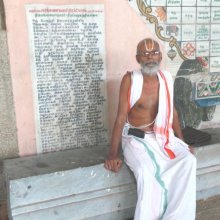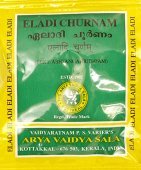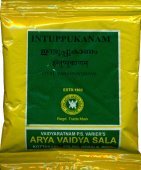Taila, Tailā, Thaila: 32 definitions
Introduction:
Taila means something in Buddhism, Pali, Hinduism, Sanskrit, Jainism, Prakrit, the history of ancient India, Marathi, Hindi, biology, Tamil. If you want to know the exact meaning, history, etymology or English translation of this term then check out the descriptions on this page. Add your comment or reference to a book if you want to contribute to this summary article.
Alternative spellings of this word include Tail.
Images (photo gallery)
In Hinduism
Ayurveda (science of life)
Dietetics and Culinary Art (such as household cooking)
Source: Shodhganga: Dietetics and culinary art in ancient and medieval IndiaTaila (तैल) refers to “oils” according to the 17th century Bhojanakutūhala (dravyaguṇāguṇa-kathana), and is commonly found in literature dealing with the topics of dietetics and culinary art, also known as Pākaśāstra or Pākakalā.—Taila-prakaraṇa describes the properties of the oil prepared from tila (sesame), eraṇḍa (castor), sarṣapa (mustard), dhānya (grains), nimbi (neem), karpūra (camphor), nārikera (coconut), āmra (mango), kusumbha (safflower), tuvarī (horse gram) and kapittha (wood apple).
In the Taila or “oils” group of foodstuffs, the following substances are beneficial (hita) to the body: Tilataila (sesame oil). The following substances are harmful (ahita) to the body: Kusumbhataila (safflower oil).
Cikitsa (natural therapy and treatment for medical conditions)
Source: Ancient Science of Life: Botanical identification of plants described in Mādhava CikitsāTaila (तैल) or Tila refers to the medicinal plant Sesamum indicum L. S. orientale L., and is used in the treatment of atisāra (diarrhoea), according to the 7th century Mādhavacikitsā chapter 2. Atisāra refers to a condition where there are three or more loose or liquid stools (bowel movements) per day or more stool than normal. The second chapter of the Mādhavacikitsā explains several preparations [including Taila] through 60 Sanskrit verses about treating this problem.
Kalpa (Formulas, Drug prescriptions and other Medicinal preparations)
Source: Shodhganga: Edition translation and critical study of yogasarasamgrahaTaila (तैल) refers to “medicated oil” and is a Sanskrit technical term appearing in the 15th-century Yogasārasaṅgraha (Yogasara-saṅgraha) by Vāsudeva..—Taila is medicated oil containing herbal extracts. For preparing medicated oil three components are used. They are liquids like decoction, juice, milk, buttermilk, meat soup etc, paste of drugs and the oil. Proportion of the recipe is thus–paste one-fourth of oil and liquid four times of oil. If more liquids are mentioned, each of them should be taken equal to the quantity of oil. If no liquid is mentioned water should be added and unless otherwise mentioned gingili oil is used. These three components are mixed and cooked together. When it is properly cooked, large number of form appear at the surface. If poured on fire it will not make sound but burns and the paste will not stick on fingers. Then it is filtered and salt or alkali is added, if necessary.
Sometimes, oils are subjected to another process called gandhapāka, i.e. rendering fragrance. Four kinds ripeness are said for medicated oils, viz. āma (half), mṛdu (mild), madhyama (intermediate) and khara (hard). Among them half boiled is without quality, mild is for snuffing, intermediate is for all purposes and hard is for smearing on the body. It is notable that oils shall not be cooked by one day.
Veterinary Medicine (The study and treatment of Animals)
Source: Asian Agri-History: Paśu Āyurvēda (Veterinary Medicine) in GaruḍapurāṇaTaila (तैल) refers to “oil” and is used in the various Anupāna (“drink take”), according to sections on the treatment of Horses (Gajāyurveda or Aśvāyurveda) in the Garuḍapurāṇa.—The Anupāna i.e. the drink take along with or after medicine was important in treatment. Because it may help in carrying, absorption, assimilation and enhancing action of the drugs. Normally the selection of anupāna is done depends upon disease, doṣa etc.—[...] In diseases of the deranged and aggravated vāyu the medicine should be administered through the taila (oil), or in combination with śarkarā (sugar), ājya/ghṛita (ghee) or toya (water).
Unclassified Ayurveda definitions
Source: Wisdom Library: Āyurveda and botanyTaila (गुड, “oil”) is a Sanskrit technical term translating to “Herbal oils” and is used throughout Ayurvedic literature such as the Caraka-saṃhitā. All traditional herbal oils are prepared with the base of Sesame oil (Sesamum indicum). It is also known by the name Tila (तिल).
Source: archive.org: Vagbhata’s Ashtanga Hridaya Samhita (first 5 chapters)Taila (तैल) refers to “sesame-oil”, which is mentioned in verse 3.13 of the Aṣṭāṅgahṛdayasaṃhitā (Sūtrasthāna) by Vāgbhaṭa.—Accordingly, “[...] Having thereupon bathed according to ritual—with the oil removed by an astringent—,rubbed (one’s body) with musk-charged saffron, (and) fumigated (oneself) with aloe-wood one shall (at last) turn to [...] fresh victuals, lard, (and) sesame-oil [viz., taila]; (besides), to tepid water for purification (and) a bed covered with a quilt, hide, and silk, ramie, or goat’s-hair sheet [...]”.
Source: Academia.edu: Ayurveda and PharmaceuticsTaila or snehapāka (Medicated oils): The medicated substances in the liquid form are boiled with recommended oils till all the water present is evaporated. The remaining oil is used as medicine both internally and externally. Oil for internal use is less boiled than those used externally. Example: Nirgunḍi taila. Oils used as external/topical application get absorbed well. The water based substances are not absorbed through skin. Hence, snehapāka is equal to parenteral route of drug administration. If honey bee or any other wax is added it turns into malaharam or ointment. Example: Sindhūrādi-lepam. The lepam (malaharam) or ointment form is more popular today than earlier. If ghṛta (ghee) is used in the place of oil, the resulting medicament is known as ghṛakalpa. Example: Jātyādighrita.
Source: gurumukhi.ru: Ayurveda glossary of termsTaila (तैल):—Oil;

Āyurveda (आयुर्वेद, ayurveda) is a branch of Indian science dealing with medicine, herbalism, taxology, anatomy, surgery, alchemy and related topics. Traditional practice of Āyurveda in ancient India dates back to at least the first millenium BC. Literature is commonly written in Sanskrit using various poetic metres.
Jyotisha (astronomy and astrology)
Source: Wisdom Library: Brihat Samhita by VarahamihiraTaila (तैल) refers to “oil”, according to the Bṛhatsaṃhitā (chapter 5), an encyclopedic Sanskrit work written by Varāhamihira mainly focusing on the science of ancient Indian astronomy astronomy (Jyotiṣa).—Accordingly, “What eclipses the moon is bigger than the moon; what eclipses the sun is smaller than the sun. Hence in semi-lunar and semi-solar eclipses, the luminous horns are respectively blunt and sharp. [...] It is wrong to say that there can be no eclipse unless five planets are in conjunction and it is equally wrong to suppose that on the previous Aṣṭamī (eighth lunar) day, the coming eclipse and its properties can be ascertained by examining the appearance of a drop of oil [i.e., taila] on the surface of water”.

Jyotisha (ज्योतिष, jyotiṣa or jyotish) refers to ‘astronomy’ or “Vedic astrology” and represents the fifth of the six Vedangas (additional sciences to be studied along with the Vedas). Jyotisha concerns itself with the study and prediction of the movements of celestial bodies, in order to calculate the auspicious time for rituals and ceremonies.
Vastushastra (architecture)
Source: OpenEdition books: Architectural terms contained in Ajitāgama and RauravāgamaTaila (तैल) refers to “sesame oil” and represents one of the ingredients of the Aṣṭabandha type of Mortar (used for fixing together the Liṅga to its Pedestal), as discussed in the Ajitāgama and Rauravāgama.—(Original source: Les enseignements architecturaux de l'Ajitāgama et du Rauravāgama by Bruno Dagens).—The aṣṭabandha or “mortar with eight ingredients” is well known but its method of preparation and the nature of the eight components sometimes vary slightly from one text to another. The ingredients of aṣṭabandha are as follows according to the Ajita-āgama (18.216-218): shellac, hematite, beeswax, sarja resin, agalloch / agarwood resin, molasses, sesame oil (taila) and limestone powder; these different products must be mixed and cooked so as to obtain a fluid substance to which an equal quantity of sarja resin , limestone powder and lime as well as buffalo butter will then be added.

Vastushastra (वास्तुशास्त्र, vāstuśāstra) refers to the ancient Indian science (shastra) of architecture (vastu), dealing with topics such architecture, sculpture, town-building, fort building and various other constructions. Vastu also deals with the philosophy of the architectural relation with the cosmic universe.
General definition (in Hinduism)
Source: archive.org: Vedic index of Names and SubjectsTaila (तैल, ‘sesamum oil’) is mentioned in the Atharvaveda, where reference is made to keeping such oil in jars. In the Śāṅkhāyana-āraṇyaka, reference is made to anointing with sesamum oil.
In Buddhism
Tibetan Buddhism (Vajrayana or tantric Buddhism)
Source: academia.edu: The Structure and Meanings of the Heruka MaṇḍalaTaila (तैल) is the name of a Vīra (hero) who, together with the Ḍākinī named Tailinī (or Tailī) forms one of the 36 pairs situated in the Guṇacakra, according to the 10th century Ḍākārṇava chapter 15. Accordingly, the guṇacakra refers to one of the four divisions of the sahaja-puṭa (‘innate layer’), situated within the padma (lotus) in the middle of the Herukamaṇḍala. The 36 pairs of Ḍākinīs and Vīras [viz., Taila] are whitish red in color; they each have one face and four arms; they hold a skull bowl, a skull staff, a small drum, and a knife.

Tibetan Buddhism includes schools such as Nyingma, Kadampa, Kagyu and Gelug. Their primary canon of literature is divided in two broad categories: The Kangyur, which consists of Buddha’s words, and the Tengyur, which includes commentaries from various sources. Esotericism and tantra techniques (vajrayāna) are collected indepently.
Mahayana (major branch of Buddhism)
Source: Wisdom Library: Maha Prajnaparamita SastraTaila (तैल) refers to the “oil (of the lamp)”, according to Mahāprajñāpāramitāśāstra (chapter 41).—Accordingly, “[The eighteen āveṇika-dharmas (‘special attributes’)]— [...] (10). The Buddha has no loss of wisdom.—He has no loss of wisdom.—As the Buddha has obtained all these wisdoms, he has no loss of wisdom; as his wisdom of the three times is unobstructed, he has no loss of wisdom. Moreover, he is endowed with the ten powers (bala), the four fearlessnesses (vaiśāradya) and the four unhindered wisdoms (pratisaṃvid): this is why he has no loss of wisdom. If the oil (taila) is plentiful and the wick (vartikā) is clean, the flame of the lamp (dīpa-jvāla) is excellent. It is the same for the Buddha who has concentrations such as the Samādhirājasamādhi as oil and, as clean wick, the absence of loss of mindfulness. This is why the radiance of his wisdom is immense and uneclipsed. [...]”.

Mahayana (महायान, mahāyāna) is a major branch of Buddhism focusing on the path of a Bodhisattva (spiritual aspirants/ enlightened beings). Extant literature is vast and primarely composed in the Sanskrit language. There are many sūtras of which some of the earliest are the various Prajñāpāramitā sūtras.
In Jainism
General definition (in Jainism)
Source: archive.org: Jaina YogaTaila (तैल, “oil”) refers to one of the ten classifications of food (āhāra), also known as vikṛtis, according to the 12th century Yogaśāstra (verse 3.130) by Hemacandra. Taila refers to oil, which may be of four kinds: sesamum, flax (atasī), mustard, and saffron (kusumbha). Other oils are not for consumption as food but are used for preparing plaster or for sticking.

Jainism is an Indian religion of Dharma whose doctrine revolves around harmlessness (ahimsa) towards every living being. The two major branches (Digambara and Svetambara) of Jainism stimulate self-control (or, shramana, ‘self-reliance’) and spiritual development through a path of peace for the soul to progess to the ultimate goal.
India history and geography
Source: Cologne Digital Sanskrit Dictionaries: Indian Epigraphical GlossaryTaila.—oils; a branch of revenue according to the Artha- śāstra. See Ghoshal, H. Rev. Syst., p. 90. Note: taila is defined in the “Indian epigraphical glossary” as it can be found on ancient inscriptions commonly written in Sanskrit, Prakrit or Dravidian languages.

The history of India traces the identification of countries, villages, towns and other regions of India, as well as mythology, zoology, royal dynasties, rulers, tribes, local festivities and traditions and regional languages. Ancient India enjoyed religious freedom and encourages the path of Dharma, a concept common to Buddhism, Hinduism, and Jainism.
Biology (plants and animals)
Source: Google Books: CRC World Dictionary (Regional names)1) Taila in India is the name of a plant defined with Eucalyptus globulus in various botanical sources. This page contains potential references in Ayurveda, modern medicine, and other folk traditions or local practices It has the synonym Eucalyptus maidenii subsp. globulus (Labill.) J.B. Kirkp..
Example references for further research on medicinal uses or toxicity (see latin names for full list):
· Journal de Botanique Société de Botanique de France (2004)
· Cytologia (1985)
· Journal of Ethnopharmacology (2002)
· Bot. Journal of the Linnean Society (1975)
· Aspects of Plant Sciences (1989)
· Journal of Ethnopharmacology (2003)
If you are looking for specific details regarding Taila, for example extract dosage, health benefits, side effects, chemical composition, pregnancy safety, diet and recipes, have a look at these references.
2) Thaila in India is identified with Eucalyptus tereticornis. It has the synonym Leptospermum umbellatum Gaertn. (among others).

This sections includes definitions from the five kingdoms of living things: Animals, Plants, Fungi, Protists and Monera. It will include both the official binomial nomenclature (scientific names usually in Latin) as well as regional spellings and variants.
Languages of India and abroad
Marathi-English dictionary
Source: DDSA: The Molesworth Marathi and English Dictionarytaila (तैल).—n S Oil.
Source: DDSA: The Molesworth Marathi and English DictionaryThailā (थैला).—m ( H) A sack or large bag. 2 A case to be stuffed (as of a pillow &c.)
Source: DDSA: The Aryabhusan school dictionary, Marathi-English1) Thailā (थैला).—m A sack or large bag. A case to be stuffed (as of a pillow &c.).
2) Taila (तैल).—n Oil.
Marathi is an Indo-European language having over 70 million native speakers people in (predominantly) Maharashtra India. Marathi, like many other Indo-Aryan languages, evolved from early forms of Prakrit, which itself is a subset of Sanskrit, one of the most ancient languages of the world.
Sanskrit dictionary
Source: DDSA: The practical Sanskrit-English dictionaryTaila (तैल).—[tilasya tatsadṛśasya vā vikāraḥ aṇ]
1) Oil; लभेत सिकतासु तैलमपि यत्नतः पीडयन् (labheta sikatāsu tailamapi yatnataḥ pīḍayan) Bhartṛhari 2.5; Y.1.284; R.8.38.
2) Benzoin.
Derivable forms: tailam (तैलम्).
Source: Cologne Digital Sanskrit Dictionaries: Shabda-Sagara Sanskrit-English DictionaryTaila (तैल).—n.
(-laṃ) 1. Oil, expressed oil, prepared from sesamum, mustard, &c. 2. Storax, gum benzoin, incense. E. tila sesamum, and aṇ aff. tilasya tatsadṛśasya vā vikāraḥ .
Source: Cologne Digital Sanskrit Dictionaries: Benfey Sanskrit-English DictionaryTaila (तैल).—i. e. tila + a, n. 1. Oil, [Yājñavalkya, (ed. Stenzler.)] 1, 283. 2. Incense, [Varāhamihira's Bṛhajjātaka.] S. 76, 4.
Source: Cologne Digital Sanskrit Dictionaries: Cappeller Sanskrit-English DictionaryTaila (तैल).—[neuter] sesamum oil, oil i.[grammar]
Source: Cologne Digital Sanskrit Dictionaries: Monier-Williams Sanskrit-English Dictionary1) Taila (तैल):—n. ([from] tila) sesamum oil, oil, [Atharva-veda i, 7, 2 (?); Kauśika-sūtra; Gobhila-śrāddha-kalpa; Manu-smṛti] etc. (ifc. [Pāṇini 5-2, 29], Vārtt.4, [Patañjali]; ifc. f(ā). , [Kumāra-sambhava vii, 9])
2) olibanum, [Varāha-mihira’s Bṛhat-saṃhitā lxxvii, 4 and 6.]
3) m. Name of a king, [Inscriptions]
Source: Cologne Digital Sanskrit Dictionaries: Yates Sanskrit-English DictionaryTaila (तैल):—(laṃ) 1. n. Oil; incense.
Source: DDSA: Paia-sadda-mahannavo; a comprehensive Prakrit Hindi dictionary (S)Taila (तैल) in the Sanskrit language is related to the Prakrit words: Tilla, Tela, Tella.
[Sanskrit to German]
Sanskrit, also spelled संस्कृतम् (saṃskṛtam), is an ancient language of India commonly seen as the grandmother of the Indo-European language family (even English!). Closely allied with Prakrit and Pali, Sanskrit is more exhaustive in both grammar and terms and has the most extensive collection of literature in the world, greatly surpassing its sister-languages Greek and Latin.
Hindi dictionary
Source: DDSA: A practical Hindi-English dictionary1) Thailā (थैला):—(nm) a bag, sack, haversack, wallet.
2) Taila (तैल) [Also spelled tail]:—(nm) oil; ~[citra] an oil painting; ~[pota] an oil tanker; ~[raṃga] oil colour; [tailākta] anointed or smeared with oil.
...
Kannada-English dictionary
Source: Alar: Kannada-English corpusTaila (ತೈಲ):—
1) [noun] the sesame oil.
2) [noun] any oil in gen.
3) [noun] any of various liquid, medicinal preparations usu. used for external applications on the body.
--- OR ---
Taiḷa (ತೈಳ):—[noun] = ತೈಲ [taila].
Kannada is a Dravidian language (as opposed to the Indo-European language family) mainly spoken in the southwestern region of India.
Tamil dictionary
Source: DDSA: University of Madras: Tamil LexiconTailā (தைலா) noun < Urdu thailē. Wooden box, trunk; மரப்பெட்டி. [marappetti.] (J.)
Tamil is an ancient language of India from the Dravidian family spoken by roughly 250 million people mainly in southern India and Sri Lanka.
Nepali dictionary
Source: unoes: Nepali-English DictionaryTaila (तैल):—n. → तेल [tela]
Nepali is the primary language of the Nepalese people counting almost 20 million native speakers. The country of Nepal is situated in the Himalaya mountain range to the north of India.
See also (Relevant definitions)
Starts with (+24): Taila-ghanaka, Tailabhavini, Tailabhyanga, Tailabija, Tailacaurika, Tailacitra, Tailadhara, Tailadhare, Tailadroni, Tailaghrita, Tailakalkaja, Tailakalpana, Tailakanda, Tailakara, Tailakita, Tailakitta, Tailakshauma, Tailakunda, Tailakundika, Tailamali.
Query error!
Full-text (+1259): Tailampata, Putitaila, Tilataila, Pitataila, Tailaparnika, Tailapaka, Tailakara, Tailati, Tailapa, Tailapayika, Tailambuka, Karpurataila, Tailadroni, Tailasphatika, Tailaparni, Tailayantra, Tailapipilika, Tailakitta, Tailacaurika, Tikshnataila.
Relevant text
Search found 76 books and stories containing Taila, Daila, Dhaila, Taiḷa, Tailā, Tailas, Thailā, Thaila, Thailaa; (plurals include: Tailas, Dailas, Dhailas, Taiḷas, Tailās, Tailases, Thailās, Thailas, Thailaas). You can also click to the full overview containing English textual excerpts. Below are direct links for the most relevant articles:
World Journal of Pharmaceutical Research
Ayurvedic thaila kalpana- a review < [2020: Volume 9, May issue 5]
Ayurveda treatment for amavata disease < [2021: Volume 10, March issue 3]
Management of amavata disease according to ayurveda < [2021: Volume 10, December issue 14]
International Ayurvedic Medical Journal
Critical evaluation of action of chinchadi thailam in osteoarthritis knee (janusandhigata vata) < [2020, Issue 5, May]
Shirobasti – a conceptual study < [2023, Issue 12, December]
Role of paada abhyanga in preventive and curative aspect < [2017, Issue IV April]
A comprehensive review on eranda thaila (ricinus communis linn.) < [Volume 4, Issue 6: November-December 2017]
"Shiroabhyanga for darunaka management: a scientific review" < [Volume 8, Issue 2: March - April 2021]
RCT on talisadi tailam for treating tinea pedis (alasa). < [Volume 8, Issue 1: January - February 2021]
Garga Samhita (English) (by Danavir Goswami)
Verse 4.8.29 < [Chapter 8 - In the Story of the Yajña-sītās, the Glories of Ekādaśī]
Verse 4.19.57 < [Chapter 19 - A Thousand Names of Srī Yamunā]
Standardisation of murivenna and hemajeevanti taila < [Volume 12 (issue 3-4), Jan-Jun 1993]
Standardization of Ayurvedic Tailas, Ayurveda Research Institute, India. < [Volume 18 (issue 3-4), Jan-Jun 1999]
Standardisation of ayurvedic oils < [Volume 17 (issue 4), Apr-Jun 1998]
Vakyapadiya of Bhartrihari (by K. A. Subramania Iyer)
Verse 2.157 < [Book 2 - Vākya-kāṇḍa]
Verse 3.14.483 < [Book 3 - Pada-kāṇḍa (14): Vṛtti-samuddeśa (On Ccomplex Formation)]
Verse 3.7.149 < [Book 3 - Pada-kāṇḍa (7): Sādhana-samuddeśa (On the Means)]
Related products
(+83 more products available)








